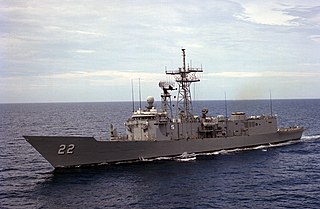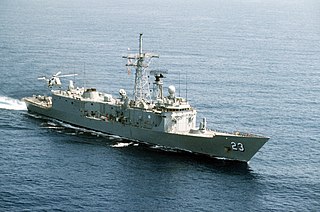 W
WThe Oliver Hazard Perry class is a class of guided-missile frigates named after the U.S. Commodore Oliver Hazard Perry, the hero of the naval Battle of Lake Erie. Also known as the Perry or FFG-7 class, the warships were designed in the United States in the mid-1970s as general-purpose escort vessels inexpensive enough to be bought in large numbers to replace World War II-era destroyers and complement 1960s-era Knox-class frigates. In Admiral Elmo Zumwalt's "high low fleet plan", the FFG-7s were the low capability ships with the Spruance-class destroyers serving as the high capability ships. Intended to protect amphibious landing forces, supply and replenishment groups, and merchant convoys from aircraft and submarines, they were also later part of battleship-centred surface action groups and aircraft carrier battle groups/strike groups. Fifty-five ships were built in the United States: 51 for the United States Navy and four for the Royal Australian Navy (RAN). In addition, eight were built in Taiwan, six in Spain, and two in Australia for their navies. Former U.S. Navy warships of this class have been sold or donated to the navies of Bahrain, Egypt, Poland, Pakistan, Taiwan, and Turkey.
 W
WThe Oliver Hazard Perry class is a class of guided-missile frigates named after the U.S. Commodore Oliver Hazard Perry, the hero of the naval Battle of Lake Erie. Also known as the Perry or FFG-7 class, the warships were designed in the United States in the mid-1970s as general-purpose escort vessels inexpensive enough to be bought in large numbers to replace World War II-era destroyers and complement 1960s-era Knox-class frigates. In Admiral Elmo Zumwalt's "high low fleet plan", the FFG-7s were the low capability ships with the Spruance-class destroyers serving as the high capability ships. Intended to protect amphibious landing forces, supply and replenishment groups, and merchant convoys from aircraft and submarines, they were also later part of battleship-centred surface action groups and aircraft carrier battle groups/strike groups. Fifty-five ships were built in the United States: 51 for the United States Navy and four for the Royal Australian Navy (RAN). In addition, eight were built in Taiwan, six in Spain, and two in Australia for their navies. Former U.S. Navy warships of this class have been sold or donated to the navies of Bahrain, Egypt, Poland, Pakistan, Taiwan, and Turkey.
 W
WUSS Copeland (FFG-25) was the seventeenth ship of the Oliver Hazard Perry class of guided-missile frigates in the United States Navy. She was named for Rear Admiral Robert W. Copeland (1910–1973).
 W
WUSS Copeland (FFG-25) was the seventeenth ship of the Oliver Hazard Perry class of guided-missile frigates in the United States Navy. She was named for Rear Admiral Robert W. Copeland (1910–1973).
 W
WUSS Fahrion (FFG-22), fourteenth ship of the Oliver Hazard Perry-class of guided-missile frigates, was named for Admiral Frank George Fahrion (1894–1970).
 W
WUSS Gallery (FFG-26), eighteenth ship of the Oliver Hazard Perry class of guided-missile frigates, was named for three brothers: Rear Admiral Daniel V. Gallery (1901–1977), Rear Admiral William O. Gallery (1904–1981), and Rear Admiral Philip D. Gallery (1907–1973). Ordered from Bath Iron Works, Bath, Maine, on 28 February 1977 as part of the FY77 program, Gallery was laid down on 17 May 1980, launched on 20 December 1980, co-sponsored by Mrs. Philip D. Gallery and Mrs. Daniel V. Gallery, and commissioned on 5 December 1981, commanded by Commander Norman Stuart Scott. Decommissioned and stricken on 14 June 1996, she was transferred to Egypt on 25 September 1996 as Taba (F916). As of 2007, she remained in active service with the Egyptian Navy.
 W
WUSS Lewis B. Puller (FFG-23) was the fifteenth ship of the Oliver Hazard Perry class of guided-missile frigates in the United States Navy. She was the first US Navy ship to be named for United States Marine Corps Lieutenant General Lewis B. "Chesty" Puller (1898–1971). Ordered from Todd Pacific Shipyards, Los Angeles Division, San Pedro, California on 28 February 1977 as part of the FY77 program, Lewis B. Puller was laid down on 23 May 1979, launched on 15 March 1980, and commissioned on 17 April 1982. Decommissioned and stricken on 18 September 1998, she was transferred to Egypt the same day as Toushka (F906).
 W
WUSS Copeland (FFG-25) was the seventeenth ship of the Oliver Hazard Perry class of guided-missile frigates in the United States Navy. She was named for Rear Admiral Robert W. Copeland (1910–1973).
 W
WUSS Fahrion (FFG-22), fourteenth ship of the Oliver Hazard Perry-class of guided-missile frigates, was named for Admiral Frank George Fahrion (1894–1970).
 W
WUSS Gallery (FFG-26), eighteenth ship of the Oliver Hazard Perry class of guided-missile frigates, was named for three brothers: Rear Admiral Daniel V. Gallery (1901–1977), Rear Admiral William O. Gallery (1904–1981), and Rear Admiral Philip D. Gallery (1907–1973). Ordered from Bath Iron Works, Bath, Maine, on 28 February 1977 as part of the FY77 program, Gallery was laid down on 17 May 1980, launched on 20 December 1980, co-sponsored by Mrs. Philip D. Gallery and Mrs. Daniel V. Gallery, and commissioned on 5 December 1981, commanded by Commander Norman Stuart Scott. Decommissioned and stricken on 14 June 1996, she was transferred to Egypt on 25 September 1996 as Taba (F916). As of 2007, she remained in active service with the Egyptian Navy.
 W
WUSS Lewis B. Puller (FFG-23) was the fifteenth ship of the Oliver Hazard Perry class of guided-missile frigates in the United States Navy. She was the first US Navy ship to be named for United States Marine Corps Lieutenant General Lewis B. "Chesty" Puller (1898–1971). Ordered from Todd Pacific Shipyards, Los Angeles Division, San Pedro, California on 28 February 1977 as part of the FY77 program, Lewis B. Puller was laid down on 23 May 1979, launched on 15 March 1980, and commissioned on 17 April 1982. Decommissioned and stricken on 18 September 1998, she was transferred to Egypt the same day as Toushka (F906).